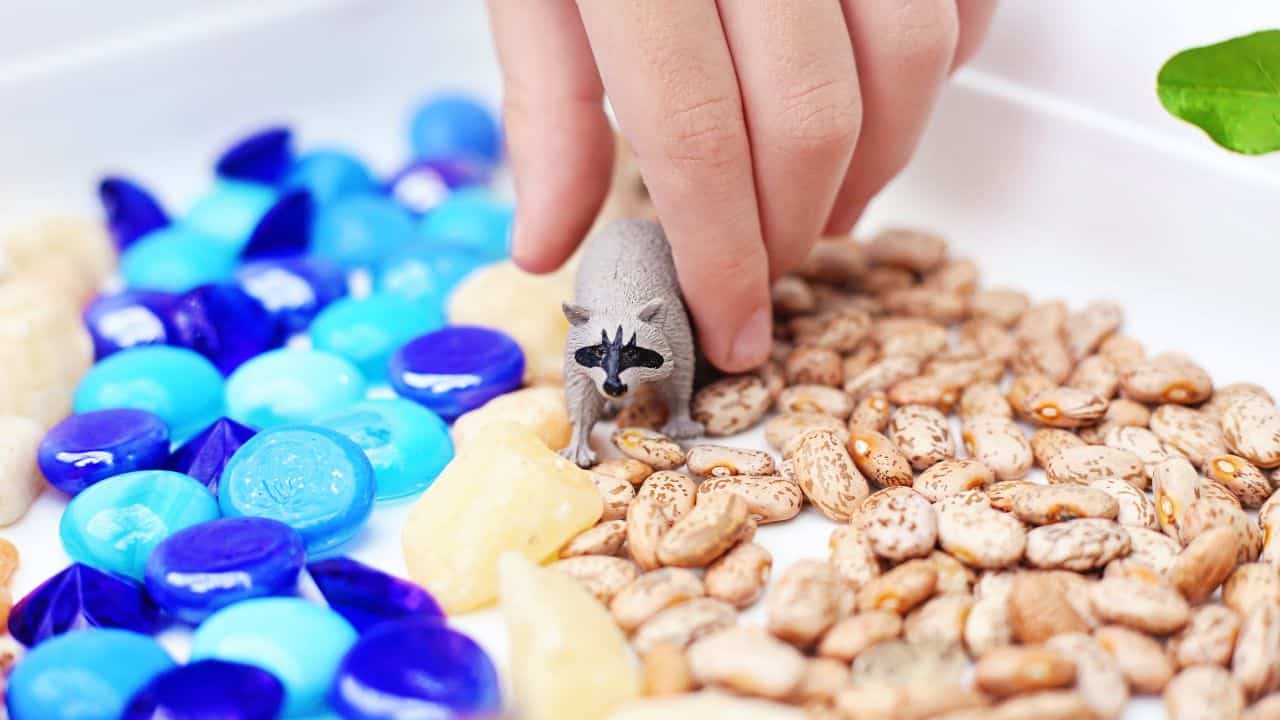As a kid, and even as an adult, I’ve always found the sound of a creek soothing. I could sit for hours just watching the water flow, hoping to spot a frog sitting on a rock.
It’s here that I drew inspiration for this little hands, big creek sensory bin–a nature-based play experience that brings the peaceful charm of a woodland stream into your home.
A creek sensory bin is a nature-inspired, hands-on activity that mimics a quiet forest stream. It encourages sensory exploration, storytelling, and wildlife curiosity—all in one bin.
Supplies and Materials

Each item brings a unique texture and role to the scene. Try sourcing natural materials like rocks and small branches from outside with your child to make the activity even more meaningful.
- Blue vase filler pebbles – These give the illusion of flowing water and shimmer beautifully under light.
- Small rocks – Used to line the creek bed, they add a tactile, realistic touch.
- Dried pinto beans – Represent the forest floor and add a different texture to explore.
- Small branches – These become trees or driftwood in your woodland scene.
- Toy animals – Beavers, raccoons, and deer help bring the forest to life and inspire imaginative play.
How Kids Play

There’s no right or wrong way to play with this sensory bin. Just let their imagination take the lead. Along the way, they’ll pick up skills like problem-solving, story telling, and fine motor coordination.
- Sensory Exploration: Kids love running their fingers through different textures. The smooth water pebbles contrast with the gritty rocks and soft beans, offering a full sensory experience. It’s also a great way to calm overstimulated kids after a busy day.
- Animal Role-Playing: Your child might create a whole storyline with the forest animals. Maybe the raccoon is sneaking snacks, or the beaver is hard at work on a dam. These little scenes help kids develop language, empathy, and storytelling skills.
- Water Flow Simulation: By shifting the pebbles, kids can reroute the creek, adding movement and problem-solving into their play. It becomes a STEM moment without even trying—learning how water might flow around objects or pool in certain areas.
- Sorting & Counting: Sensory bins sneak in early math skills in the most natural way. Kids can count rocks, sort animals, or group items by size or texture, boosting both logic and vocabulary.
Benefits

Beyond the fun, this activity offers real developmental perks like fine motor skills and creative thinking. It’s simple and meaningful.
- Encourages Imaginative Play: Kids can dream up their own woodland stories, building confidence in their creativity and giving them a peaceful place to “escape” to.
- Enhances Fine Motor Skills: Moving pebbles, placing animals, and digging through beans all strengthen little fingers and coordination—great prep for writing and other skills.
- Supports Sensory Development: This activity taps into touch, sight, and even sound (those pebbles clink softly!), supporting kids with sensory sensitivities or just helping them unwind.
- Teaches About Nature: It’s a hands-on way to introduce basic ecology—how animals interact with their environment, what a beaver dam looks like, or how trees grow along creeks.
- Promotes Independent Play: This setup encourages kids to explore and create on their own terms, which is especially helpful for quiet solo play or screen-free time.
Other Nature Activities You’ll Love
- Build a bird nest activity
- Water flow creek exploration
- Firefly catching sensory bin
Frequently Asked Questions
What age is this sensory bin best for?
It’s ideal for ages 3 and up, though younger toddlers can enjoy it too with supervision (especially due to small parts).
Can I make this sensory bin mess-free?
Try placing it on a tray or shallow plastic tub with a towel underneath. You can also take it outside for easy cleanup.
Are there alternatives if I don’t have all the supplies?
Absolutely! Use rice dyed blue instead of vase filler, cotton balls for clouds or foam water, and any small toys or sticks you have on hand.
Can this be reused?
Yes! Just store the items in a resealable bag or container. You can rotate new animals or natural elements to keep it fresh.
Is this a good activity for calm-down time?
Yes. The soft textures and quiet play style make it a wonderful calming activity, especially before nap time or after school.

Leave a Reply